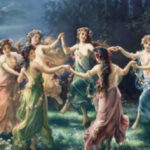 Music
Music  Music
Music  Weird Stuff
Weird Stuff 10 Unbelievably Bizarre Blunders
 History
History 10 Doomsday Scenes from the Year Without a Summer
 Technology
Technology 10 Surprising Truths About the Power Grid You Were Never Told
 Food
Food 10 Most Outrageous Restaurant Food Challenges
 Facts
Facts 10 Interesting and Bizarre Facts About Vending Machines
 Technology
Technology 10 Ancient “Smart” Materials Scientists Still Can’t Reproduce
 Gaming
Gaming 10 Games Milked for All Their Worth
 Our World
Our World 10 Things That Will Make You Rethink Everything Normal
 Animals
Animals 10 Times the Christian Church Took on the Animal Kingdom
 Music
Music 10 Bands That Originally Had Terrible Names
 Weird Stuff
Weird Stuff 10 Unbelievably Bizarre Blunders
 History
History 10 Doomsday Scenes from the Year Without a Summer
Who's Behind Listverse?

Jamie Frater
Head Editor
Jamie founded Listverse due to an insatiable desire to share fascinating, obscure, and bizarre facts. He has been a guest speaker on numerous national radio and television stations and is a five time published author.
More About Us Technology
Technology 10 Surprising Truths About the Power Grid You Were Never Told
 Food
Food 10 Most Outrageous Restaurant Food Challenges
 Facts
Facts 10 Interesting and Bizarre Facts About Vending Machines
 Technology
Technology 10 Ancient “Smart” Materials Scientists Still Can’t Reproduce
 Gaming
Gaming 10 Games Milked for All Their Worth
 Our World
Our World 10 Things That Will Make You Rethink Everything Normal
 Animals
Animals 10 Times the Christian Church Took on the Animal Kingdom
Top 10 Composers You Don’t Know
It is very possible that you may know one or two of these composers, but unless you are a student of music or a great classical music fanatic, the chances are you don’t, though you have probably heard some of their music in films. These are not film composers normally – they are classical composers in their own right. They are great pioneers in classical music from the 20th century. As you can see, the Americans dominate the field a little (that may just be my personal preference though.) In no particular order:
1. Alfred Schnittke, Russian [Born: 1934; Died: 1998]
Here we have the Schnittke Concerto Gross for 2 Violins – movement 2: Toccata. This piece perfectly sums Schnittke’s music up – we have delicate pretty tunes on the solo instruments which start to explode into a sound world that is totally unique to this composer. Listen for little snippets of other famous pieces – Schnittke loved to quote a famous piece and then rip it to shreds. He was one of the first modern composers to restore the Concerto Grosso form, and he loved to use unusual instruments such as Electric Guitars, jazz drums, honky tonk piano, and he frequently used the harpsichord and celesta. I believe that Schnittke will be remembered as a Mozart of the 20th century.
Transform into your own composer with Media Composer 7 at Amazon.com!
2. Charles Ives, American [Born: 1874; Died: 1954]
There is no doubt that Ives is American’s most American composer. In the piece here Putnam’s Camp, Redding Connecticut, from his Three Places in New England, you get to hear the true Ivesian spirit come out. You hear quotes of very famous American tunes that Ives heard as a young man. He would incorporate them in to his music and wreak havoc on them (much the same as Schnittke does – though Ives did it first). It is believed that Charles Ives (who worked as a full time insurance broker in the daytime) used most of the 20th century styles of composition before anyone else making him one of the most important composers of the century. When you listen to this piece don’t think you are hearing a bad performance – the “messy” sound is correct. Ives loved to mix a variety of sounds together in total discord with each other. He was very much a joker and often wrote funny comments in his music scores. If you don’t believe he had talent, watch this video of his most famous piece, the Unanswered Question (and arguably his most moving).
3. Karlheinz Stockhausen, German [Born: 1928]
The video is not his, but the music is. This piece, Kontakte is a piece of classical electronic music. Stockhausen was a pioneer in the field of electronic music. He is probably most famous for his Helicopter String Quartet (you can watch thirty seconds of it here) which is, as it is entitled, a piece for a string quartet and four helicopters. It is part of one of the operas in his “Light” cycle and has already been performed in public. The entire piece is mesmerizing.
4. George Crumb, American [Born: 1929]
Crumb received a lot of exposure when some of his music (Night of the Electric Insects from Black Angels) was featured in the Exorcist. This piano piece is A little Suite for Christmas – Adoration of the Magi. He often asks for instruments to be played in unusual ways and several of his pieces are written for electrically amplified instruments. Crumb’s music often seems to be concerned about the theatre of performance as much as the music itself. In several pieces he asks players to leave and enter the stage during the piece. He has also used unusual layouts of musical notation in a number of his scores. In several pieces, the music is symbolically laid out in a circular or spiral fashion.
5. Sofia Gubaidulina, Tartar [Born: 1931]
Gubaidulina’s music is marked by the use of unusual instrumental combinations. In In Erwartung, she combines percussion and saxophone quartet. She has written pieces for Japanese koto and Western orchestra. In the early 1980s, she began to use the Fibonacci sequence as a way of structuring the form of the work. The sequence was especially appealing because it provides a basis for composition while still allowing the form to “breathe”. It plays a prominent role in such pieces as Perception, Im Anfang war der Rhythmus, Quasi hoketus and the symphony Stimmen… Verstummen… She is the only female composer on this list but she definitely deserves the honor. The piece we hear above is the fourth part of her Viola Concerto (1996/97).
Get free shipping, thousands of movies, and millions of streaming songs with a FREE trial of Amazon Prime at Amazon.com!
6. Iannis Xenakis, Greek [Born: 1922; Died: 2001]
This is the Xenakis Synaphai pour piano et 86 musiciens. Romanian born Xennakis was one of the most important modernist composers of the 20th century ; a major figure in the postwar development of musical modernism, and an architect. Xenakis’s primary teachers of composition were Arthur Honegger, Darius Milhaud, and Olivier Messiaen. At the time he began composing in earnest, Xenakis had not had much formal study of music and almost nothing of theory, and so he studied harmony and counterpoint with whoever was willing to accept him as a student despite his vast gaps in knowledge and reluctance to defer to established authority. He is particularly remembered for his pioneering electronic and computer music, and for the use of stochastic mathematical techniques in his compositions, including probability.
7. Alban Berg, Austrian [Born: 1885; Died: 1935]
The video footage is not the best but this is the best scene from Alban Berg’s masterpiece opera Lulu. In the scene here we see the circus master introducing the characters of the opera as animals (Lulu is the snake). This is the first opera ever composed entirely by twelve-tone rows – this means that you must use each note of the scale only once until all notes of the scale have been used. Berg mastered the skill of this style (serial composition) and managed to make beauty out of maths. The opera ends with a gruesome scene in which Lulu is murdered by Jack the Ripper. Berg was a student of Schoenberg.
8. Aaron Copland, American [Born: 1900; Died: 1990]
I selected this particular video because it has the best quality sound of all the versions on youtube. It is the Fanfare for the Common Man. Most people will know the piece but not the composer as it has been played more than once at Olympic games. It is an incredibly stirring piece of music. Copeland wrote a lot of film music but was eventually banned because of the belief that he had communist leanings. He has also written a magnificent opera called the Tender Land which features some of the most beautiful writing by an American composer. This is a particularly moving piece of music. Unfortunately it does not include the whole piece so you will need to buy it.
9. John Cage, American [Born: 1912; Died: 1992]
Cage is one composer you may have heard of – simply because of his infamy. Cage is the composer of the very famous 4’33” – four and a half minutes of silence. While Cage did write a great deal of fairly normal sounding music, his experimentation with sound makes him the leader avant garde composer of the 20th century. He frequently uses tape recordings, natural sounds, electronic sounds, and everyday objects to produce his unique style of music. He was also a firm proponent of the prepared piano. He wrote a great deal of chance music – in which the music is created by rolling a dice, flipping a coin, or any other random method. Above we hear his Imaginary Landscape No. 1 set to various images and video clips.
10. Anton Webern, Austrian [Born: 1883; Died: 1945]
Like Alban Berg, Webern was a student of Arnold Schoenberg – the three composers are now regarded as forming the Second Viennese School – the first of which was Mozart, Haydn, Beethoven, and Schubert. Webern was not a prolific composer; just thirty-one of his compositions were published in his lifetime, and when Pierre Boulez oversaw a project to record all of his compositions, including those without opus numbers, the results fit on just six CDs. Webern’s style is typified by very spartan textures, in which every note can be clearly heard; carefully chosen timbres, often resulting in very detailed instructions to the performers and use of extended instrumental techniques (flutter tonguing, col legno, and so on); wide-ranging melodic lines, often with leaps greater than an octave; and brevity: the Six Bagatelles for string quartet (1913), for instance, last about three minutes in total. The piece above – number two of the Funf Satze clearly shows Weberns style.
Technorati Tags: 20th century, classical, music








